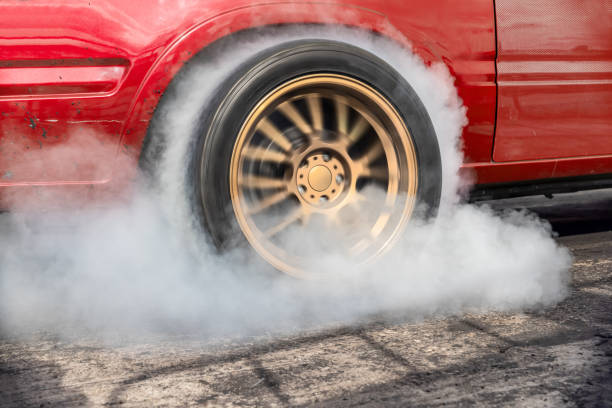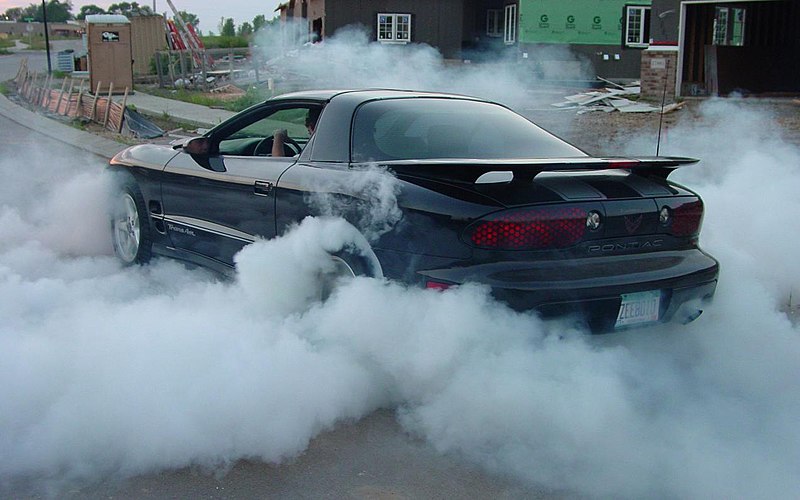Your car started roaring the engine, but it remained stationary even though the 2 rear wheels started spinning and sliding on the road surface… That was Burnout! Burnouts can be accomplished using just a few simple steps, but the steps differ depending on what you’re driving. So if you’re a beginner and wonder how to do a burnout in a manual transmission, let’s follow the guides in our article below:
Contents
What Is A Burnout Car?
According to the Dictionary of Car Enthusiasts, burnout is a technique that keeps the vehicle stationary, spinning the rear wheel and causing the tire to heat up and smoke due to friction gradually. Burnout is a traditional way of warming up tires before a race. Warming up the tires softens the rubber and cleans dirt from the tires, giving the car a much better grip. Tires are one of the most important parts, related to the performance and operation of a car and are also the only part of the car that comes into contact with the road, that’s why the burnout technique is quite essential before every race.

Burnout happens when engine power overcomes the friction between the tires and the road surface and the braking system is powerful enough to keep the vehicle from moving forward. At that time, there will be strong friction between the tires and the road surface, causing the rubber to melt, creating smoke. During the burnout process, the tire temperature can reach over 204 degrees Celsius depending on the time and level of friction.
In every professional race, there is usually a specific area for Burnout cars, the “Burnout box”, this area is watered to reduce friction between the tires and the road surface, making it easier for cars to burn out before each match. Currently, some racing cars are equipped with a Line Lock system (independent brakes on the 2 front wheels or 2 rear wheels) to serve Burnout most simply.
Burnout is not difficult, the driver just needs to be flexible with a few operations according to the vehicle type. Now, let’s find out how to burn out with a manual transmission.
How To Do A Burnout In A Manual Transmission?
Burnouts can be very exciting to show off your driving skills, however, if you don’t do it properly, it will be dangerous so here’s a step-by-step guide on how do you do a burnout safely and effectively:
Preparation
Burning out your tires is a technique that requires a lot of techniques and will be risky in some cases so that’s why preparation is key:
- To perform a burnout, you need to wear a seatbelt and find a wide-open place free from pedestrians and obstacles to practice. You should make sure that there is at least a probability of 50 to 100 feet in front of your car because if your brakes fail, your car will take off and it will be very dangerous. Do not do burnouts on public streets.
- Don’t forget to check the tire condition before doing the burnout process. If your tire is worn out, it will probably blow out during the burnout.
- Ensure the traction control and stability control are fully disabled before the burnout otherwise your car will prevent the tires from spinning.

Steps by step to do a burnout
- Manual transmission, front-wheel drive
- Engage the parking brake: This prevents the car from rolling while you build revs
- Shift into 1st gear and hold the clutch (disengage the clutch)
- Step on the accelerator to 3,000-4,000, depending on your vehicle
- Release the clutch and hold the accelerator, the front wheels spin
- Control the accelerator according to the Burnout level, but do not let the engine rpm touch the red zone
- End burnout, reduce the throttle, release the handbrake, and let your tires cool down before driving
- Manual transmission, rear-wheel drive
- Put in 1st gear and hold the clutch (disengage the clutch)
- Press the accelerator to slowly increase the engine rpm up to about 4,000 rpm
- Quickly switch the clutch to the brake pedal while keeping the right foot steady
- Control the engine rpm and brake pedal force. Add more gas, reduce the brake to the most appropriate time enough to make the rear wheel spin (overcome the brake force and road friction force), and keep the vehicle stationary.
- Reduce the throttle to end the burnout.
Note: When you feel the car tilting to either side, you are losing control. In this case, you should release the clutch quickly and let go of the throttle in one motion. Try it a few times until you get used to it.
>> Read more: How To Do A Burnout In An Automatic: A Simple Way
Are Burnouts Bad For Your Car?
While it may be tempting to try burning out your tires, it can put extra stress on your car and can cause some wear and tear:
- The most obvious consequence is that the tires wear out super fast. A proper tire burnout is the same as your tires being driven for 1000 km which will significantly shorten the lifespan of your tires. Not only that, when doing a burnout, it will create intense heat which can damage the tire structure and blowout.
- Using the brake pedal during the burnout process can generate a lot of heat which can reduce its effectiveness and overheat the brake system.
- With an automatic transmission, do not increase the engine speed too high and then suddenly shift gears, because you can cause serious damage to the transmission
- Break the axle when burnout
- Destroy the clutch if burnout is not done properly
- Damage the engine if it operates continuously at maximum speed.
Watch more:
Doing burnout is not good for your car, it can result in a lot of problems, not only for the brake and tire but also for redlining and hurting your car’s engine. So regular drivers shouldn’t try to perform a burnout on regular vehicles as this may cause irreparable damage to your car parts. And this activity is best left to drag racing professionals.
We hope that you will learn something from this topic. If you have any comment, let’s leave it in the comment section below:



